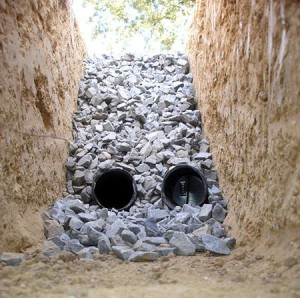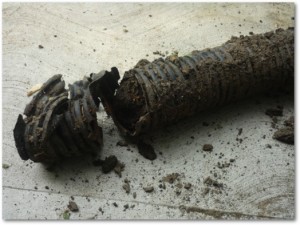Exterior Waterproofing
Doing it from the outside is what everyone seems to think of when the topic of waterproofing comes up. “Why not waterproof outside?” This is very logical and also very true. Please read the Why Basements Leak page before this page.
From the Start
The best and most thorough waterproofing that will ever be done on the outside will be done by the builder of the house. They are capable of doing every wall, corner, and footing before the driveway is poured or any other obstructions are installed preventing access to the full wall and full perimeter to the exterior of the foundation wall. It is very common for there to be exterior drainage pipes that either run to a lower part of land or to the storm drains, or to an interior sump pump. The exterior walls are often coated with tar sealant (which gets very brittle and cracks -especially across the wall/footer seam), or with a dimpled material called MiraDrain (which comes in long sheets – it is very easy for water to skirt around the side of or thru any connection errors). These attempts keep the water off the foundation wall and to try to keep it dry are known by all builders to be completely temporary. If any of the exterior systems fail their replacement is very costly due to the fact that excavation must go to the footer (typically 8 to 10 ft. deep) and ideally would surround the whole house as water will only pour to the lowest level. For safety reasons for every foot of depth down you must go a foot away from the house creating a very wide hole and destroying a lot of yard. This is done to prevent excavation collapse (a fatal and very common event). Another big cost comes with the fact that you must remove (and ideally replace) anything against/above the foundation wall or its surrounding dirt this means the removal of: decks, porches, driveways, trees, landscaping. Depending on the situation the removal and replacement of these fixtures can be costly.
Outside Waterproofing Methods
The goal of exterior waterproofing is to prevent water from entering foundation walls and seams with the hope of preventing the wicking and molding of any building materials.
Exterior Drainage Systems
Exterior drainage systems are most often based on 4″ perforated PVC pipes to collect water from around the outside of the footer and drain it to another nearby location. Ideally these locations are substantially lower than the footer they are trying to drain. If there is not adequate pitch it is possible for the drains to actually add water to the foundation rather than drain it from the foundation. Without proper discharge the water will not be able to drain in time causing back up at the footer. Another problem is that this back and forth movement of water introduces mud, silt and stone into the drain pipes, clogging them at a much faster rate. Below is an image of exterior drainage pipes being installed.
Below is an image of the same type of pipe after a few years underground.
Tar and Polymer-based products
The past 30 years has seen the development of polymer-based waterproofing products. These products have low enough viscosity that it can be sprayed directly onto a wall. This is commonly called “tar damp-proofing”. This uses a degradable asphalt-based covering sprayed directly onto the foundation wall. If this is applied correctly with adequate exterior and interior catch all drainage system it can keep a basement dry for many years. But because it is tar (decayed plant product) the soil pH degrades it. It works very well for the short term as it is flexible. The problem is that with temperature changes and from getting wet and dry repeatedly it gets very brittle. The foundation wall settles and or moves with slight ground movement (mostly caused by soil expansion caused by the drying and soaking of the surrounding soil). As this happens the tar applied at the footer/wall seam cracks and leaks (recall, this seam is a little deeper underground than your basement floor. Often 8-10 ft). It is very common to see people applying tons of tar to the wall, but not focusing on the wall/footer seam at the bottom of the wall. This displays a lack of understanding of where the water is actually entering. Still, any tar will eventually dry and crack at the point of movement. This point may be the wall/footer seam, wall/chimney seam, or a wall/wall seam as in a walk out stairwell. These are all common leak points.
Vinyl Sheeting
After seeing the failures of tar based waterproofing systems builders and some waterproofing companies turned to vinyl sheeting systems to cover the outside wall. These systems are nearly impossible to correctly seal to concrete walls and almost never last more than a few seasons. The main problem is in the fact that once concrete has become damp any adhesives will simply not stay adhered completely. Once the vinyl sheeting fails it takes on water. Once this happens the water is then trapped behind the sheet, forming a bag of water on the foundation wall which slowly drains into the basement and also prevents the wall from properly drying.





